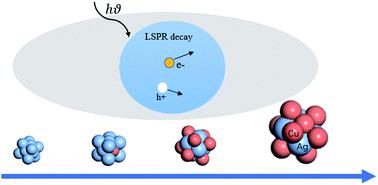Our official English website, www.x-mol.net, welcomes your
feedback! (Note: you will need to create a separate account there.)
Cu–Ag alloy for engineering properties and applications based on the LSPR of metal nanoparticles
RSC Advances ( IF 3.9 ) Pub Date : 2020-4-1 , DOI: 10.1039/d0ra01474e Chao-Chao Jian 1 , Jianqi Zhang 1 , Xiangchao Ma 1
RSC Advances ( IF 3.9 ) Pub Date : 2020-4-1 , DOI: 10.1039/d0ra01474e Chao-Chao Jian 1 , Jianqi Zhang 1 , Xiangchao Ma 1
Affiliation

|
Efficient generation of high-energy hot carriers from the localized surface plasmon resonance (LSPR) of noble metal (Ag, Au and Cu) nanoparticles is fundamental to many applications based on LSPR, such as photovoltaics and photocatalysis. Theoretically, intra- and inter-band electron transitions in metal nanoparticles are two important channels for the non-radiative decay of LSPR, which determine the generation rate and energy of hot carriers. Therefore, on the basis of first-principles calculations and Drude theory, in this work we explore the potential role of alloying Ag with Cu in modulating the generation rate and energy of hot carriers by studying the intra- and inter-band electron transitions in Cu, Ag and Cu–Ag alloys. It is meaningful to find that the d-sp inter-band electron transition rates are notably increased in Cu–Ag alloys. In particular, the inter-band electron transition rates of Cu0.5Ag0.5 become larger than that of single Cu and Ag across the whole energy range between 1.5 and 3.2 eV. In contrast, intra-band electron transition rates of Cu–Ag alloys become smaller than that of single Cu and Ag. Because the intra-band electron transitions mainly contribute to the resistive loss in metals, which finally results in a thermal effect rather than high-energy hot carriers, the reduction of intra-band electron transitions in Cu–Ag alloy is beneficial for the transforming the energy absorbed by LSPR into high-energy hot carriers through other non-radiative channels. These results indicate that alloying of Ag and Cu can effectively improve the generation rates of high-energy hot carriers through the inter-band electron transition, but decrease the resistive loss through intra-band transition of electrons, which should be used as a guide in optimizing the non-radiative decay processes of LSPR.
中文翻译:

基于金属纳米粒子的 LSPR 工程性能和应用的 Cu-Ag 合金
从贵金属(Ag、Au 和 Cu)纳米粒子的局域表面等离子共振 (LSPR) 高效生成高能热载流子是许多基于 LSPR 的应用的基础,例如光伏和光催化。理论上,金属纳米粒子的带内和带间电子跃迁是 LSPR 非辐射衰变的两个重要通道,它决定了热载流子的产生速率和能量。因此,基于第一性原理计算和 Drude 理论,在这项工作中,我们通过研究 Cu 中的带内和带间电子跃迁,探索了 Ag 与 Cu 合金化在调节热载流子产生速率和能量方面的潜在作用。 , Ag 和 Cu-Ag 合金。发现 d-sp 带间电子跃迁率在 Cu-Ag 合金中显着增加是有意义的。0.5银0.5在 1.5 到 3.2 eV 的整个能量范围内,它变得比单个 Cu 和 Ag 的更大。相比之下,Cu-Ag 合金的带内电子跃迁率变得小于单一的 Cu 和 Ag。由于带内电子跃迁主要导致金属中的电阻损耗,最终导致热效应而不是高能热载流子,因此Cu-Ag合金中带内电子跃迁的减少有利于转变LSPR 通过其他非辐射通道将能量吸收到高能热载流子中。这些结果表明,Ag和Cu的合金化可以通过带间电子跃迁有效提高高能热载流子的生成速率,但通过电子的带内跃迁降低电阻损耗,
更新日期:2020-04-01
中文翻译:

基于金属纳米粒子的 LSPR 工程性能和应用的 Cu-Ag 合金
从贵金属(Ag、Au 和 Cu)纳米粒子的局域表面等离子共振 (LSPR) 高效生成高能热载流子是许多基于 LSPR 的应用的基础,例如光伏和光催化。理论上,金属纳米粒子的带内和带间电子跃迁是 LSPR 非辐射衰变的两个重要通道,它决定了热载流子的产生速率和能量。因此,基于第一性原理计算和 Drude 理论,在这项工作中,我们通过研究 Cu 中的带内和带间电子跃迁,探索了 Ag 与 Cu 合金化在调节热载流子产生速率和能量方面的潜在作用。 , Ag 和 Cu-Ag 合金。发现 d-sp 带间电子跃迁率在 Cu-Ag 合金中显着增加是有意义的。0.5银0.5在 1.5 到 3.2 eV 的整个能量范围内,它变得比单个 Cu 和 Ag 的更大。相比之下,Cu-Ag 合金的带内电子跃迁率变得小于单一的 Cu 和 Ag。由于带内电子跃迁主要导致金属中的电阻损耗,最终导致热效应而不是高能热载流子,因此Cu-Ag合金中带内电子跃迁的减少有利于转变LSPR 通过其他非辐射通道将能量吸收到高能热载流子中。这些结果表明,Ag和Cu的合金化可以通过带间电子跃迁有效提高高能热载流子的生成速率,但通过电子的带内跃迁降低电阻损耗,











































 京公网安备 11010802027423号
京公网安备 11010802027423号